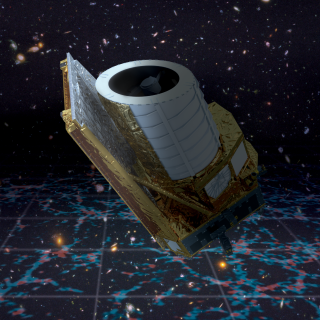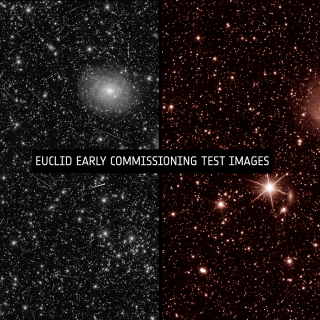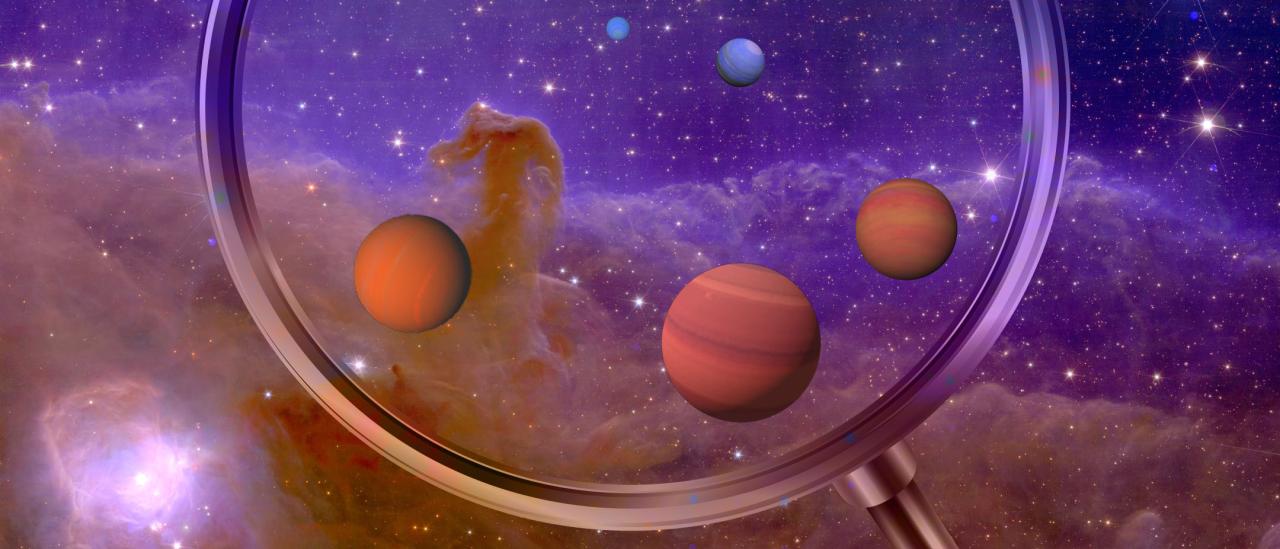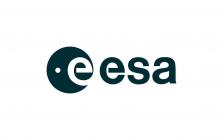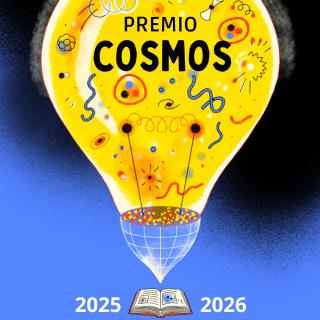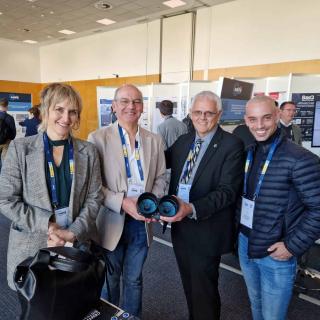Image obtained with Euclid showing a a spectacularly panoramic and detailed view of the Horsehead Nebula, also known as Barnard 33 and part of the constellation Orion. In this stellar nursery, scientists hope to find many dim and previously unseen Jupiter-mass planets in their celestial infancy, as well as young brown dwarfs and baby stars. Eduardo Martín Guerrero de Escalante, research professor at the IAC, has been the principal investigator of this Euclid image. Credits: ESA/Euclid/Euclid Consortium/NASA. Image processing: J.-C. Cuillandre (CEA Paris-Saclay), G. Anselmi; CC BY-SA 3.0 IGO. Design: Gabriel Pérez Díaz and Eduardo L. Martín Guerrero de Escalante.
ESA’s Euclid space mission reveals its first full-colour images of the cosmos. Never before has a telescope been able to create such razor-sharp astronomical images across such a large patch of the sky, and looking so far into the distant Universe. These images illustrate the telescope's potential to create the largest and most accurate 3D map of the Universe to date. The Instituto de Astrofísica de Canarias (IAC) has led one of the first five Euclid Early Release Objects (ERO) programmes.
95% of our cosmos appears to be made of these mysterious ‘dark’ entities But we don’t understand what they are because their presence causes only very subtle changes in the appearance and motions of the things we can see. To reveal the ‘dark’ influence on the visible Universe, over the next six years Euclid will observe the shapes, distances and motions of billions of galaxies out to 10 billion light-years. By doing this, it will create the largest cosmic 3D map ever made.
What makes Euclid’s view of the cosmos special is its ability to create a remarkably sharp visible and infrared image across a huge part of the sky in just one sitting. The images released today showcase this special capacity: from bright stars to faint galaxies, the observations show the entirety of these celestial objects, while remaining extremely sharp, even when zooming in on distant galaxies.
“We have never seen astronomical images like this before, containing so much detail. They are even more beautiful and sharp than we could have hoped for, showing us many previously unseen features in well-known areas of the nearby Universe. Now we are ready to observe billions of galaxies, and study their evolution over cosmic time,” says René Laureijs, ESA’s Euclid Project Scientist.
“I wish to congratulate and thank everyone involved with making this ambitious mission a reality, which is a reflection of European excellence and international collaboration. The first images captured by Euclid are awe-inspiring and remind us of why it is essential that we go to space to learn more about the mysteries of the Universe,” says ESA Director General Josef Aschbacher.
Major Spanish contribution
Euclid has a 1.2-metre diameter telescope and two instruments on board: VIS (VISible instrument) and NISP (Near-Infrared Spectrometer and Photometer). The latter is a near-infrared spectrometer and photometer that has been developed with extensive Spanish participation, organised around two poles that joined the scientific consortium in 2010.
On the one hand, the Institute of Space Sciences (ICE-CSIC), the Institute of High Energy Physics (IFAE), the Institute of Space Studies of Catalonia (IEEC) and the Scientific Information Port (PIC), have been responsible for the design, construction, assembly and validation tests of the NISP instrument filter wheel, as well as the cosmological simulations of the mission.
On the other hand, the Polytechnic University of Cartagena (UPCT) and the Instituto de Astrofísica de Canarias (IAC), have been in charge of the electronic unit that controls the NISP instrument and its startup software. Besides, both nodes participate in several teams to prepare the scientific exploitation of the telescope data. Furthermore, in more than 20 Spanish institutions there are around 100 scientists arranging the scientific exploitation of the mission to unravel the mysteries of the dark universe.
“It is extraordinarily pleasing and rewarding to see these beautiful images taken with an instrument that we have built over so many years. It is amazing to realise that something that you have built is far away in space and is able to reveal the universe in such detail. We are looking forward to the science discoveries to come.”, says ICE-CSIC and IEEC researcher and member of the Euclid Consortium Francisco Castander.
"The Euclid mission begins an exploration of the Universe that is unprecedented in sensitivity, depth and scale. This observatory will unveil in the coming years unprecedented aspects of the nature of dark matter and dark energy, but it will also provide new insights into galaxies and some of the most elusive constituents of our Milky Way," says Rafael Rebolo, director of the IAC, member of the Euclid consortium and co-investigator of the mission.
“In the first images of Euclid we are already obtaining that expectations are exceeded, allowing us to go beyond what was expected in the limits of detection. We are sure that, in the coming years, Euclid will help us discover an unprecedented number of dark ultracold objects of substellar mass, facilitating a great advance in the investigation of their curious properties and it is even possible that we can reveal their mysterious origin,” says Eduardo Martín Guerrero de Escalante, IAC research professor, principal investigator of one of the first five Euclid images announced by ESA (the one that includes the Horse Nebula in Orion) and one of the two Euclid mission Independent Legacy Scientists.
"Although its primary objective is the study of the dark components of the universe (matter and energy), Euclid will also revolutionise our knowledge of the physics of galaxies by providing images with a quality superior to that of the Hubble space telescope of an area of the sky 100 times larger than it has been able to observe in more than 20 years of operation. With Euclid we are fully entering the era of big-data astronomy," explains Marc Huertas-Company, the IAC researcher responsible for the exploitation of Euclid in the characterisation of galaxy structure.
"Euclid will allow us to reconstruct with unique detail and precision the history of the Universe and to understand the physical processes responsible for the formation of the large clusters of galaxies that we observe today," says Carlos Gutierrez, IAC researcher and coordinator of the internal development of the Euclid project. "Moreover, the observation programmes carried out in recent years with other ground-based telescopes - in which the IAC has participated through GTC and the SHARKS infrared mapping system - complement the Euclid data and allow their optimal scientific exploitation. Likewise, the quantity and quality of the Euclid data will open up new lines of study and will guide much of the astrophysical research in the coming years," he adds.
“These fantastic images are the first among thousands to come to help us understand what the real content of our accelerated expanding universe is. Even if the commissioning phase is not complete, we can already see the unprecedented capabilities of Euclid and how the instruments we have built during several years work together perfectly. I am looking forward to seeing the rich scientific results that are about to come”, adds Cristóbal Padilla, IFAE researcher and member of the Euclid Consortium.
In addition, Euclid Consortium members and researchers responsible for the contribution of the UPCT in Euclid for engineering, Rafael Toledo, and science, Anastasio Díaz Sánchez and Antonio Pérez Garrido, highlight “the enormous satisfaction of seeing how technology and science developed in Spanish universities occupy a prominent a place in such a historic mission as Euclid.”
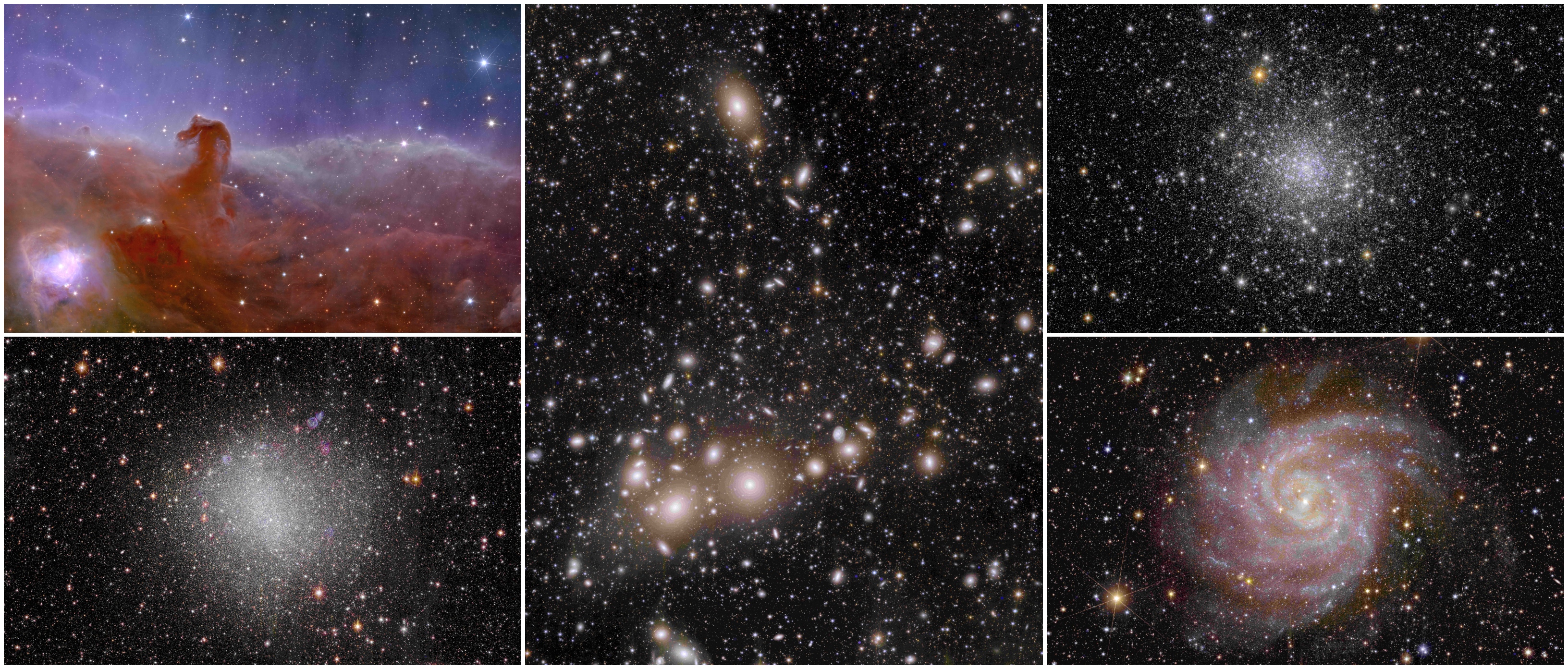
New discoveries, soon
Euclid’s first view of the cosmos is not only beautiful, but also immensely valuable for the scientific community. Firstly, it showcases that Euclid’s telescope and instruments are performing extremely well and that astronomers can use Euclid to study the distribution of matter in the Universe and its evolution at the largest scales. Combining many observations of this quality covering large areas of the sky will show us the dark and hidden parts of the cosmos. Secondly, each image individually contains a wealth of new information about the nearby Universe
Euclid launched to the Sun-Earth Lagrange point 2 on a SpaceX Falcon 9 rocket from Cape Canaveral Space Force Station in Florida, USA, on 1 July 2023. In the months after launch, scientists and engineers have been engaged in an intense phase of testing and calibrating Euclid’s scientific instruments. The team is doing the last fine-tuning of the spacecraft before routine science observations begin in early 2024.
Over six years, Euclid will survey one third of the sky with unprecedented accuracy and sensitivity. As the mission progresses, Euclid’s bank of data will be released once per year, and will be available to the global scientific community via the Astronomy Science Archives hosted at ESA’s European Space Astronomy Centre in Spain.
Euclid is a European mission, built and operated by ESA, with contributions from NASA. The Euclid Consortium – consisting of more than 2000 scientists from 300 institutes in 13 European countries, the US, Canada and Japan – is responsible for providing the scientific instruments and scientific data analysis. In addition, around 80 European companies participate in Euclid, of which 9 are Spanish, including Airbus, Alter Technology, Crisa, Deimos Space, GTD, Navair, Sener and Thales Alenia Space Spain.
For detailed information about Euclid images, please check the ESA Press Release
Contacts at the IAC:
Rafael Rebolo, rrl [at] iac.es (rrl[at]iac[dot]es)
Carlos Gutiérrez, carlos.gutierrez [at] iac.es (carlos[dot]gutierrez[at]iac[dot]es)
Eduardo Martín Guerrero de Escalante, ege [at] iac.es (ege[at]iac[dot]es)
Marc Huertas-Company, mhuertas [at] iac.es (mhuertas[at]iac[dot]es)
Other contacts:
Francisco Castander (ICE-CSIC, IEEC), fjc [at] ice.csic.es (fjc[at]ice[dot]csic[dot]es)
Cristobal Padilla (IFAE), Cristobal.Padilla [at] ifae.es (Cristobal[dot]Padilla[at]ifae[dot]es)
Rafael Toledo (UPCT), Rafael.Toledo [at] upct.es (Rafael[dot]Toledo[at]upct[dot]es)
Jorge Rivero González (Euclid Consortium Spanish press contact), rivero [at] ice.csic.es (rivero[at]ice[dot]csic[dot]es)

